
About UsThe Numismatic Bibliomania Society is a non-profit organization promoting numismatic literature. For more information please see our web site at coinbooks.org SubscriptionsThose wishing to become new E-Sylum subscribers (or wishing to Unsubscribe) can go to the following web page link MembershipThere is a membership application available on the web site Membership Application To join, print the application and return it with your check to the address printed on the application. Membership is only $15 to addresses in the U.S., $20 for First Class mail, and $25 elsewhere. For those without web access, write to: David M. Sundman, Secretary/TreasurerNumismatic Bibliomania
Society AsylumFor Asylum mailing address changes and other membership questions, contact David at this email address: dsundman@LittletonCoin.com SubmissionsTo submit items for publication in The E-Sylum, just Reply to this message, or write to the Editor at this address: whomren@coinlibrary.com
BUY THE BOOK BEFORE THE COINYou won't regret it! |
- WAYNE'S WORDS: THE E-SYLUM APRIL 15, 2012
- THE ASYLUM VOLUME 29, NO. 4
- KOLBE & FANNING'S FIRST "BUY OR BID" SALE
- OROSZ HIGHLIGHTS E-SYLUM HISTORY
- PHILATELIC BIBLIOPOLE OFFERS QUARTERMAN PUBLICATIONS
- ERROR COINS PIONEER AND AUTHOR ARNOLD MARGOLIS
- VERNE R. WALRAFEN 1940-2012
- QUIZ ANSWER: OREGON BEAVER GOLD COIN INITIALS
- QUERY: ECKFELDT-DUBOIS' MANUAL OF GOLD AND SILVER COINS
- QUERY: ECKFELDT FAMILY WAX PORTRAIT IDENTIFICATION SOUGHT
- QUERY: AUCTION CATALOG PHOTO COPYRIGHTS
- QUERY: ZINC COIN COLORING
- HARVEY STACK ON NUMISMATICS IN 1947
- THE IRIS WIRELESS TELEGRAPH ART DECO MEDAL
- NOTES FROM E-SYLUM READERS: APRIL 15, 2012
- ROBERT HEWITT'S CURIOUS 1793 AMERI. CHAIN CENT
- WAYNE'S NUMISMATIC DIARY: APRIL 15, 2012
- HAROLD LEVI COMMENTS ON JEFFERSON DAVIS IMAGES
- SMITHSONIAN HIGHLIGHTS TITANIC CARNEGIE HERO MEDAL
- KELLY & OLIVER ON THE DALLES MINT
- THE BANK OF ESTONIA MONEY MUSEUM
- BOWERS OFFERS TANENBAUM CIVIL WAR TOKENS
- SOME SOUTH AFRICAN KRUGERRANDS FOUND TO BE UNDERWEIGHT
- FEATURED WEB SITE: USPATTERNS.COM
WAYNE'S WORDS: THE E-SYLUM APRIL 15, 2012

New subscribers this week include Bob Jesinger of Vacaville, CA, Robert T Wimbrow, Michael Rice and Kathy Lawrence. Welcome aboard! We have 1,529 email subscribers, plus 174 followers on Facebook.
This week we open with a note about the latest issue of our print journal, an announcement from Kolbe & Fanning, and an article about the newsletter in your hot little hands, The E-Sylum.
Other topics include: Arnold Margolis and Verne Walrafen, Eckfeldt-DuBois, Civil War tokens and the Money Museum of the Bank of Estonia.
To learn more about undertaker tokens, the driest hands in the coin business, "the old mint that never was", J. N. T. Levick's Book of Rubbings and Sylvester Crosby's worst numismatic mistake, read on. Have a great week, everyone!
THE ASYLUM VOLUME 29, NO. 4
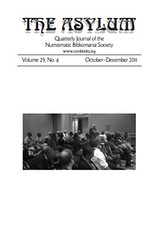 The editor of our print journal, David Yoon writes:
The editor of our print journal, David Yoon writes:
I've sent another issue of The Asylum to the printers. Here are the contents:
- Pete Smith - Three Degrees of Dave Bowers
- Myron Xenos - "You Don't Say": Numismatic Quarterly Quiz
- James Higby - Looks Like I Picked the Wrong Week to Give Up Sniffing Books
Also, the supply of articles has been a little slow lately. I'd like to make a general appeal to the E-Sylum readership: if anyone has an idea or a draft of something that would make a good Asylum article, I'd encourage them to work on it and send it in. The first 29 volumes have barely begun to explore the range of topics in numismatic literature and history of numismatics that are worthy of attention.
Remember, while The E-Sylum is free to all, only member of the Numismatic Bibliomania Society receive our print journal, The Asylum.
There is a membership application available on the NBS web site. To join, print the application and return it with your check to the address printed on the application. Membership is only $15 to addresses in the U.S., $20 for First Class mail, and $25 elsewhere.
Here's the link: www.coinbooks.org/club_nbs_member_app.html
KOLBE & FANNING'S FIRST "BUY OR BID" SALE
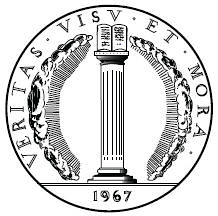 Kolbe & Fanning Numismatic Booksellers are announcing their first "Buy or Bid Sale," which will close on Wednesday, May 9. The sale is designed to sell hundreds of lots cheaply, giving collectors an opportunity to add to their libraries at inexpensive prices.
Kolbe & Fanning Numismatic Booksellers are announcing their first "Buy or Bid Sale," which will close on Wednesday, May 9. The sale is designed to sell hundreds of lots cheaply, giving collectors an opportunity to add to their libraries at inexpensive prices.
The sale will be online only: there will be no printed catalogue. The PDF catalogue will be available for downloading from the Kolbe & Fanning website at www.numislit.com sometime this week. An email will be sent to all K&F customers for whom they have addresses once the catalogue is posted; postcards will also be sent.
As the name of the sale suggests, customers may bid on items they wish to acquire or buy them outright at the published price. The Terms of Sale will give full instructions on how to participate.
The sale consists of items that have remained unsold in previous mail-bid sales. "Buy" prices have been kept low to promote sales. To further encourage participation, the firm is offering free postage to addresses in the U.S. for bidders spending at least $500; there will also be no packing and processing fee for this sale. Again, please read the Terms of Sale before participating.
If you wish to be added to Kolbe & Fanning's email list, or if you have any questions about the sale, please write to David Fanning at df@numislit.com. He can also be reached at (614) 414-0855.
The Buy or Bid Sale should be posted to www.numislit.com by Friday, April 20.
OROSZ HIGHLIGHTS E-SYLUM HISTORY
"Anybody here have email?"
It would be surprising if, in 2012, any working-age person would fail to answer "yes" to this question.
Twenty years ago, however, when Numismatic Bibliomania Society member Wayne Homren began asking that of his fellow NBS members, hardly anyone responded. The Internet was second nature to Wayne, for he had been using it since 1980, when he had started working at Bell Labs.
Finally, in August of 1998, at the NBS annual meeting in Portland, Ore., a dozen hands went up, and Wayne sniffed opportunity. He envisioned an electronic newsletter that could keep NBS members in contact with each other between appearances of their quarterly print journal, The Asylum.
Accordingly, on the morning of Sept. 4, 1998, the NBS's inaugural email publication was sent to 49 wired members. It didn't have a name at first. Wayne wanted to call it The Babbler - that being what people in an asylum are wont to do - but NBS Board members liked his second choice, The E-Sylum, suggesting an electronic version of The Asylum.
By any name, The E-Sylum was a hit. Only a few hours after its first inbox appearance, the roster of subscribers grew to 59: an increase of more than 20 percent in a single day! The list quadrupled during the next six years, in the process outstripping the membership of the NBS. Today, more than 1,500 E-Sylumites scattered around the world eagerly await the lengthening shadows of Sunday evening, when the latest version, still edited by its founder, pings into the email inbox.
To read the complete article, see: Wayne's world: E-Sylum an instant hit (www.coinworld.com/articles/waynes-world/)
PHILATELIC BIBLIOPOLE OFFERS QUARTERMAN PUBLICATIONS
Al Hoch formed Quarterman Publications in the early 1970's; intending to reprint books of lasting value; decent paper and binding with good printing at reasonable prices. He obtained excellent advice and without exception everything he reprinted was a work of enduring value, even today!.
We stocked his philatelic books from day one and as Al's health declined in recent years we bought all of some that remained. Al died on Thanksgiving day, 2010, we have acquired a stock of items found in his warehouse, some were previously thought to be sold out but two to seven of some were found.
All that knew Al have kind memories. On two occasions Al reduced the price of two books; he asked us how many we had in stock and refunded the difference!
We intend to eventually list all of Al's philatelic publications including some that are long out of print.
Confederate Postal History, An Anthology from The Stamp Specialist edited by Francis J. Crown, Jr.,
Surveys of the Confederate Postmaster's Provisionals by F. J. Crown Jr. 1984, 742 pages, cloth, edition 550.
Printing Postage Stamps by Line Engraving by James Baxter A basic work for any collector of engraved US stamps 1982, reprint of 1939 book, 164 pages.
The First Hundred Years of US Territorial Postmarks 1787-1887 by Dr. Carroll Chase & Richard Mc P. Cabeen 1980 reprint of 1950 book, 341 pages, cloth.
History of the US Post Office to the Year 1829 by Wesley E. Rich A fine history prepared as a 1977 reprint of 1924 book, 190 pages, cloth, long out of print.
California, Gold Rush Steamers of the Pacific by Ernest A. Wiltsee 1976 reprint of 1938 book, 496 pages, 90 new philatelic photographs.
Pennsylvania Postal History, The First Post Offices and First Postmasters from 1775 to 1994 by John L. Kay and Chester M. Smith Jr 1996, 644 pages, cloth, a completely new edition.
Leonard H. Hartmann
Philatelic Bibliopole
PO Box 36006, Louisville, Ky 40233
http://www.pbbooks.com
Leonard@pbbooks.net
THE BOOK BAZARRE
ERROR COINS PIONEER AND AUTHOR ARNOLD MARGOLIS
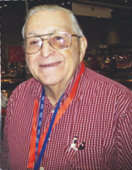 Pioneer error and variety authority Arnold Margolis has died and California error dealer Fred Weinberg wrote a tribute March 27 when he received the news. It is presented in part below.
Pioneer error and variety authority Arnold Margolis has died and California error dealer Fred Weinberg wrote a tribute March 27 when he received the news. It is presented in part below.
With the passing of Arnold Margolis, the error coin hobby has lost one of the original pioneers of this segment of coin collecting. I had the honor and pleasure of knowing Arnie for almost 50 years - and I've always credited Arnie as being one of the three people who encouraged and motivated me to become a coin dealer, which has been my profession for 40 years.
Arnie was a former Senior Video Control Engineer for NBC for over 35 years and was proud of his decades of work there, and his contacts with history, including being on the NBC team that presented the funeral of John F. Kennedy in 1963.
Arnie was a member of the Board of CONE (Collectors of Numismatic Errors), the first major national error club and was also the first president of it's off-shoot, NECA (Numismatic Error Collectors of America). His participation in numismatics also included being past president of the Queens County Coin Club and of NECOLI (Numismatic Error Collectors of Long Island).
His list of authored books and publications include: How Error Coins Are Made in the U.S. Mints, The Error Collector's handbook, Mint Errors on Carson City Dollars, The Error Coin Encyclopedia (4 editions), The Numismatic Error Primer, co-author of The Design Cud, and long-time publisher of NECA's monthly Errorscope.
A tireless advocate for education and knowledge in the coin hobby, one of his proudest achievements was the continual publication, since 1968 Error Trends Coin Magazine, which was issued without interruption until early 2011. It was the first commercial error publication.
Arnie, along with Mort Goodman (deceased) were the face of the error hobby In the 1960s when Goodman got to New York and finally met Arnie, the two became fast friends, starting Mar-Good, a company that issued the very first coin boards to hold errors.
I had been writing back and forth with Arnie since about 1964, and met him for the first time at the inaugural "Error-A-Rama" coin show - the very first coin show dedicated to error coins, at the Hollywood Roosevelt Hotel in the summer of 1967. Arnie, along with Mort Goodman and Syd Kass, let me help with the convention and show exhibits, and my enthusiasm and knowledge gained from it led me to a 40-year profession as a coin dealer.
To read the complete article, see: Pioneer in error field dies (www.numismaticnews.net/article/pioneer-in-error-field-dies)
VERNE R. WALRAFEN 1940-2012
Ralph Winter writes:
I want to let you know that E-Sylum subscriber Verne Walrafen (walrafen@gmmnut.com) passed away unexpectedly (or "caught the westbound" as we say at the Original Hobo Nickel Society) on April 5, 2012.
Verne was the Original Hobo Nickel Society's (OHNS) secretary from 2002 until his passing and the OHNS webmaster from 2004 up until now.
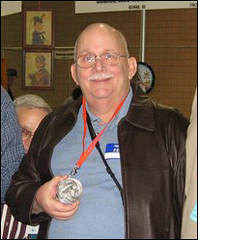 Verne R. Walrafen, 71, was born on October 23, 1940 in Emporia, Kansas to Mary Ray Walrafen and Norman O. Walrafen. He was a loved husband of over 45 years to his wife, Caroline, father to his daughters, Sonya (Brant) Hanna, Dawn Hovey, and Natasha (Brian) Uhlrich and "Big Papa" to his nine grandchildren. His sister, Juanita Shipley, lives in Blaine, WA
Verne R. Walrafen, 71, was born on October 23, 1940 in Emporia, Kansas to Mary Ray Walrafen and Norman O. Walrafen. He was a loved husband of over 45 years to his wife, Caroline, father to his daughters, Sonya (Brant) Hanna, Dawn Hovey, and Natasha (Brian) Uhlrich and "Big Papa" to his nine grandchildren. His sister, Juanita Shipley, lives in Blaine, WA
Verne was a U.S. Navy Veteran, serving during the Viet Nam war. A very intelligent man, he earned a Bachelor of Science degree in Engineering from Kansas University and a Master Degree in Computer Science from Kansas State University. Verne retired in 1997 after 30 dedicated years as a Civil Engineer for the Kansas Department of Transportation in Topeka.
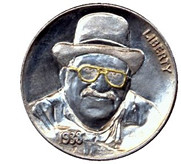 He was a valued member of the Original Hobo Nickel Society and dearly supported that art up to his very last day. A man of many interests, he enjoyed animals, nature, reading, fishing, computers, and good food. Throughout his life he could be found with a science fiction book and Mountain Dew in hand. Those who knew him were fortunate to benefit from his intelligence, generosity and humor. He will be dearly missed.
He was a valued member of the Original Hobo Nickel Society and dearly supported that art up to his very last day. A man of many interests, he enjoyed animals, nature, reading, fishing, computers, and good food. Throughout his life he could be found with a science fiction book and Mountain Dew in hand. Those who knew him were fortunate to benefit from his intelligence, generosity and humor. He will be dearly missed.
If you wish to join the Original Hobo Nickel Society (OHNS) or are renewing your membership. Please send payment to Ralph Winter, 5608 Glen Oak Court, Saline, MI 48176-9545 rather than the Ozakie, Kansas address that is noted on the membership form.
If you have any enquiries regarding the OHNS or Verne Walrafen, you can contact Ralph Winter at hobobazoo@gmail.com.
To read the complete article, see: www.hobonickels.org
QUIZ ANSWER: OREGON BEAVER GOLD COIN INITIALS

1849 $5 Oregon Beaver gold coin (image from CoinFacts.com)
Joe Boling writes:
"K.M.T.A.W.R.G.S." are the initials of the principals of the Oregon Exchange Company (I'm not going to invest the time needed to run them down). "T.O." is a typo for "O.T." (Oregon Territory).
Pete Smith writes:
Kilbourne, Magruder, Taylor, Abernathy, Wilson, Rector, Gill, Campbell and Smith: Territory of Oregon. Too easy!
Bob Neale had a more nuanced answer:
Kilborne, Magruder, Taylor, Abernethy, Wilson, Rector, Campbell and Smith set up the Oregon Exchange Co. I don't think there was a "G" but rather a "C". I don't know for sure, but guess that T.O. stands for Territory of Oregon.
The dies contained two errors. Instead of "O.T." for Oregon Territory, "T.O." was mistakenly engraved, and where each partner's last initial appeared on the coins, Campbell's incorrectly appears as a "G." The company to avoid delay did not refashion the flawed dies.
While the $5 coins were being struck, Victor M. Wallace was engraving the dies for a $10 coin. The T.O. was properly changed to O.T., and C was substituted for the G in Campbell. The initials A (Abernethy) and W (Wilson) were omitted since they did not contribute toward purchasing the new equipment.
To read the complete article, see: Territorial : Oregon Gold (www.pcgscoinfacts.com/Hierarchy.aspx?c=850)
To read the complete article, see: MORE ON THE PROPOSED U.S MINT AT THE DALLES, OREGON (www.coinbooks.org/esylum_v15n15a10.html)
QUERY: ECKFELDT-DUBOIS' MANUAL OF GOLD AND SILVER COINS
Ralf W. Böpple of Stuttgart, Germany writes:
Specific issues of the Eckfeldt-DuBois work have been discussed at several occasions. But is there a bibliography of the "Manual of Gold and Silver Coins of All Nations" that list all the editions and varieties? Or has there been a sale of a run of these editions that could serve as such a listing?
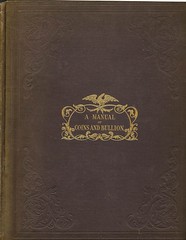 "A treatise on coins," write the authors, "which does not present a picture of them, is but half fitted for its purposes." Yet a decade before the numismatic boom of the 1850s, it was obvious that coin books needed to be picture books. The first chapters of this work concentrate on technical specifications of world gold and silver coinage, a subject near and dear to Eckfeldt and DuBois as assayers of the U. S. Mint. But the real fun starts in chapter six, when Joseph Saxton's steam-powered medal ruling machine is put to work on electrotypes produced from Mint cabinet specimens, most notably an 1804 dollar. The results were remarkable for the time, especially as Saxton's contraption automated the entire process.
"A treatise on coins," write the authors, "which does not present a picture of them, is but half fitted for its purposes." Yet a decade before the numismatic boom of the 1850s, it was obvious that coin books needed to be picture books. The first chapters of this work concentrate on technical specifications of world gold and silver coinage, a subject near and dear to Eckfeldt and DuBois as assayers of the U. S. Mint. But the real fun starts in chapter six, when Joseph Saxton's steam-powered medal ruling machine is put to work on electrotypes produced from Mint cabinet specimens, most notably an 1804 dollar. The results were remarkable for the time, especially as Saxton's contraption automated the entire process.
Sixteen plates are included in all, two with American content. Another prize is the frontispiece, an image of the second United States mint, produced using the daguerreotype, electrotype, and Saxton's medal ruler - a trio of the latest technology. That one of the first American daguerreotypes was executed by Saxton himself, peering out of the same building, in 1839, only heightens the sense of promise of illustrative science that Eckfeldt and DuBois captured for posterity.
To read the complete bibliography page, see:
A MANUAL OF GOLD AND SILVER COINS OF ALL NATIONS STRUCK WITHIN THE PAST CENTURY
(wiki.coinbooks.org/index.php/A_MANUAL_OF_GOLD_AND
_SILVER_COINS_OF_ALL_NATIONS_STRUCK_WITHIN_THE_PAST_CENTURY)
QUERY: ECKFELDT FAMILY WAX PORTRAIT IDENTIFICATION SOUGHT
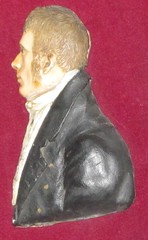 When I saw the article seeking identification of the nineteenth century portrait a couple weeks back, it sparked my interest because of a wax portrait I have that came down through the Eckfeldt family. Unfortunately its positive identification didn't come along with it, but I was told it might be of Adam Columbus Eckfeldt who was the brother of Jacob Reese Eckfeldt, the subject of the water color portrait in last week's E-Sylum.
When I saw the article seeking identification of the nineteenth century portrait a couple weeks back, it sparked my interest because of a wax portrait I have that came down through the Eckfeldt family. Unfortunately its positive identification didn't come along with it, but I was told it might be of Adam Columbus Eckfeldt who was the brother of Jacob Reese Eckfeldt, the subject of the water color portrait in last week's E-Sylum.
And, incidentally, this wax portrait was restored by Donna Weaver, who has done engraving and designing for the U. S. Mint. I would be happy if anyone out there can positively identify this fine-looking gentleman!
QUERY: AUCTION CATALOG PHOTO COPYRIGHTS
Ralf W. Böpple writes:
Is it possible (that is, allowed under copyright and related laws) to use the photograph of a coin in an auction catalog as illustration in an article, with full and correct citation of course? Or is there a difference between an auction catalog and a scientific publication? Would the consent of the auction house be needed, and what happens if the auction house is no longer in existence?
When the auction house is no longer in business permission must still be sought - someone out there is still the owner of that copyright. Often this is a successor firm to the one that produced the catalog, but it can be difficult to sort this out. -Editor
QUERY: ZINC COIN COLORING
Jim Duncan of New Zealand writes:
I have acquired a nice set of four Bohemia-Moravia Protectorate coins in zinc. They may have been cleaned as they have a nice white - almost aluminium - colour, rather than the almost black grey I am used to. Can one of your experts tell me how to retain this colour without harm. Slabbing is OUT.
THE BOOK BAZARRE
HARVEY STACK ON NUMISMATICS IN 1947
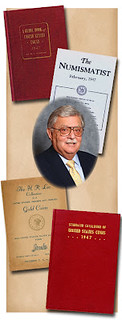 Although I had been in and out of the Stack's stores as a youngster, I began working full-time with my father, Morton, and my Uncle Joseph B. Stack in 1947 when the firm they had founded in 1933 was located at 12 West 46th Street. Stack's had already outgrown its downtown starting point at 690 Sixth Avenue and its first midtown premises at 32 West 46th. Before very long, changing patterns of businesses located on 46th Street would make another move necessary, but for now this location near the bustling Diamond District seemed ideal.
Although I had been in and out of the Stack's stores as a youngster, I began working full-time with my father, Morton, and my Uncle Joseph B. Stack in 1947 when the firm they had founded in 1933 was located at 12 West 46th Street. Stack's had already outgrown its downtown starting point at 690 Sixth Avenue and its first midtown premises at 32 West 46th. Before very long, changing patterns of businesses located on 46th Street would make another move necessary, but for now this location near the bustling Diamond District seemed ideal.
My dad and uncle owned the building in which we were located. The premises included our upstairs auction gallery, as ads of the time boast, but change was on the way. The war had been over for two years and despite some pessimistic predictions in the American Numismatic Association journal The Numismatist, coin market prices were not just holding up, they were starting a remarkable advance that would set the tone through the beginning of the 1950s and far beyond.
New York City was very much "the place to be" in 1947. The glittering era of the Twenties was now only a memory, and the terrible years of the Depression in the 1930s were now receding into the past. The city's reforming mayor Fiorello H. LaGuardia was at the United Nations and the government was inching back toward the more free-wheeling habits of earlier years.
In the world of numismatics, New York was in transition from the pre-war world typified by such giants as publisher-dealer Wayte Raymond, whose Standard Catalogue of United States Coins dominated the U.S. field. Just off the press in Racine, Wisconsin, was the first edition of the Guide Book of United States Coins, compiled by Richard S. Yeoman and published by Whitman. Soon known everywhere as "The Red Book," this slim volume swept the world of coin collecting thanks to its popular style and Whitman's unmatched distribution network, which included such outlets as Woolworth's as well as to book stores and coin dealers.
The premier collectors' group in Manhattan was the New York Numismatic Club (NYNC), then approaching its 40th anniversary and headed in 1947 by Joseph H. Spray, whose collecting emphasized the finest condition available in both U.S. and British coins. Spray was a regular at Stack's, as were his successors as NYNC president, Damon G. Douglas and Martin F. Kortjohn.
Noted as an organizer of coin clubs in Connecticut as well as New York was Oscar G. Shilke, co-founder of the New York Numismatic Conventions, of which Stack's was long the official auctioneer. These were men of imposing presence to a young dealer as I was in 1947. None was as imposing as Harold S. Bareford, a man of strong opinions to match his rugged features.
I was once horrified to see Bareford handling major American rarities with his fingers and spoke up, "Mr. Bareford, you shouldn't be touching those coins with your bare hands!" He froze me with a glance, extended his powerful hands toward me and growled, "Young man, I have the driest hands in the business!"
Other clubs then active and playing a role in the Metropolitan New York Numismatic Conventions were the Bronx Coin Club, and the Fairfield County (Connecticut) and New Jersey groups. Stack's enjoyed close ties to all of these groups, although only NYNC is still fully active into the 21st century.
1947 was a delightful year for me, and I recall it with warm satisfaction, as many of the friendships formed then continued for years to come, some even until today.
To read the complete article, see: Remember When: 1947, It Was A Very Good Year! (stacksbowers.com/Blogs/remember-when-1947-it-was-very-good.html)
THE IRIS WIRELESS TELEGRAPH ART DECO MEDAL
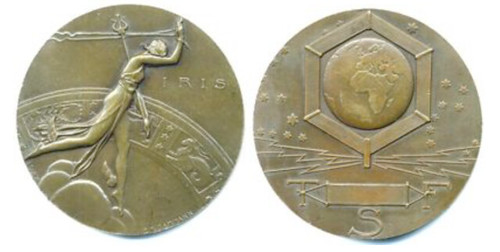
IRIS - WIRELESS TELEGRAPH ART DECO MEDAL, 1927. CGI: 3:116A 67.5mm. Bronze. Paul Marcel Dammann, Sc. (Paris Mint. Edge marked with cornucopia BRONZE.) Choice About Uncirculated. Obverse with a classical figure of Iris, stepping through the clouds with the signs of the Zodiac contained within a rainbow behind her. The reverse bears a world globe encircled by an antenna emitting radio waves, Below: TSF (telegraphie sans fil - wireless)
Mark Jones notes that in this medal,
"Dammann was able to glorify that most intangible of achievements, the radio, by taking the classical figure, Iris, who was traditionally a messenger of the gods, and adapting her symbolic significance to modern times. She is shown with the signs of the zodiac contained with the rainbow, with which she is generally associated, to indicate the speed with which radio waves move through the heavens."
One of the classic art deco images.
NOTES FROM E-SYLUM READERS: APRIL 15, 2012
Leather Medal of Georg Hulbe
Regarding an eBay sale lot, Harry Waterson writes:
I hope this went to a bibliomaniac. It does seem a perfect fit. A leather medal by a bookbinder advertising his wares. With a wonderful misspelling!
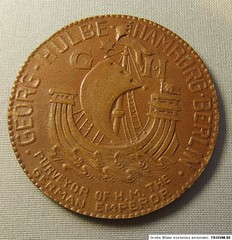

To read the complete eBay listing, see: Leather medal of Artist -- Georg Hulbe --- Hamburg-- Berlin -- Very Rare (www.ebay.com/itm/170814483151)
Atwood Token Catalog Editions
Bill Burd writes:
I'm probably not the first to tell you that a 6th Edition of the Atwood-Coffee Catalog of United States and Canadian Transportation Tokens was issued in 2007.
I have a copy in my library along with the first edition 1958 Atwood; the 2nd edition 1963; 4th edition volume one 1983.
Actually, Bill WAS the first, but right on his heels was Dick Grinolds, who writes:
There was one minor biblio error in David Gladfelter's story on our friend John Coffee. The Atwood-Coffee Catalog Of United States And Canadian Transportation Tokens is now in its sixth edition published in 2007 and not the fifth as mentioned in the story.
The cover color of the familiar thick catalog has graduated from the old familiar red to maroon to forest green to the current royal blue of the sixth edition. There have been yearly (I believe) cumulative updates of the monthly new additions and corrections to the catalog published in a softcover booklet and offered to the membership of the AVA each summer.
As mentioned, Volume Two - History And Encyclopedia Of Transportation Tokens (tons of information and photos!!!) and Volume Three - Die Varieties have not been updated.
To read the earlier E-Sylum article, see: FARE BOX EDITOR DR. JOHN COFFEE SIDELINED BY INJURY (www.coinbooks.org/esylum_v15n15a05.html)
Another Reader Bit By April Fools
Leon Parev writes:
I was totally taken in by the MacNall article. I thought, don't these guys ever learn? Glad to learn it was a prank
To read the earlier E-Sylum article, see: ANA TO NAME NEW EXECUTIVE DIRECTOR (coinbooks.org/esylum_v15n14a06.html)
Coins of the Sultan of Swat
Mark A. Brown of Syracuse writes:
I read with interest the report of reactions to your April 1 announcement of the startling choice of a new executive director for the ANA. I had written an April 1 article for inclusion in our local East Syracuse Coin Club newsletter, but found at the April 2 meeting that seemingly all 105 members had been taken in by my fabrication.
For what it's worth, and for the enjoyment of the apparently more alert audience of the E-Sylum, I give the article below:
A numismatic first is reportedly scheduled for release on April 1st.
The island of Swat, one of those innumerable oil-rich sultanates, is issuing its first coinage, beginning with gold and silver coins honoring local hero George H. Ruth, who became the first Sultan of the nation when it won independence from its neighbors in 1935. At that point Ruth set aside his earlier role as a playboy sportsman and settled down to the serious duties of a statesman, though he never lost his interest in the world of sports.
Ruth was an unusual choice for the nation's first leader. His father was an American and so many considered him a yankee, but he actually had dual citizenship and returned intermittently to the capital city of Bahstn, where he always made a big hit and where he was first recognized as a charismatic leader.
The coins are being issued in unusual dual denominations. The gold coin is marked as a 100 euro coin, but also marked in the equivalent in the slightly inflated local currency, which works out to the unusual denomination of 2217 arbiyaye. The 1 euro silver coin is also denominated as 714 hoamrz.
We've seen somewhat unusual denominations from other countries, once in a while-you may recall the St. Lucia coins mentioned in the January issue, one for 2 livres, 5 sous and another for 6 livres, 15 sous, for example-but surely the numbers 2217 and 714 have never before come up as the value of a coin.
Nor are any of us likely to see them again.
Corrections: April 8, 2012
Pete Mosiondz, Jr. was the first to report the typo in last week's Featured Web Page article. A close second was Jim Duncan of New Zealand, who writes:
Man, Elizabeth THE FIRST handing out the Maundy coins - I'll have a set please!
Right. We'll correct this to read Elizabeth II. Sorry!
To read the earlier E-Sylum article, see: FEATURED WEB PAGE: QUEEN HANDS OUT MAUNDY MONEY (www.coinbooks.org/esylum_v15n15a24.html)
Dave Lange writes:
When I first saw the photograph captioned "Adjustors in the 1850s," I immediately sensed two errors: The style of dress is wrong for the that time period, and a photo of that quality and depth could not have been achieved in the 1850s. I was starting to think 1890s, when I noticed that the date 1897 appears right on the photo itself.
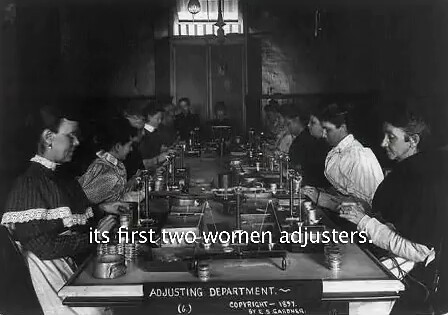
Joe Boling writes:
The link to the video on women at the Mint and BEP returns this message: "This video has been removed by the user. Sorry about that."
To read the earlier E-Sylum article, see: WOMEN AT THE U.S MINT AND BEP (www.coinbooks.org/esylum_v15n15a15.html)
Joe Boling smelled something funny in this quoted Wikipedia entry:
"Hewitt commissioned sculptor Jules Edouard Roiné of Paris for the design and the medal "offered a stinking frontal bust in high relief."
Joe writes:
Stinking?
A Poet Defines 'Coin'
Dick Johnson writes:
Poet David Orr defines "Coin" in the February 6, 2012 issue of The New Yorker, as: "two faces, divided, together." Wished I'd said that!
ROBERT HEWITT'S CURIOUS 1793 AMERI. CHAIN CENT
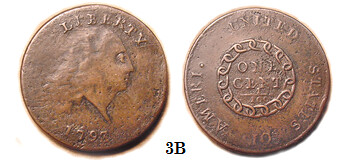
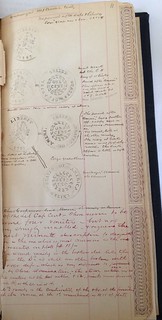 Probably the worst numismatic mistake Sylvester Crosby ever made was on a 1793 chain cent owned by Robert Hewitt. In his 1896-7 AJN monograph - The Cents of 1793, Crosby describes the "B" reverse: "I have found only one impression of this die and cannot now trace that, but describe and illustrate it from a copy taken some years ago."
Probably the worst numismatic mistake Sylvester Crosby ever made was on a 1793 chain cent owned by Robert Hewitt. In his 1896-7 AJN monograph - The Cents of 1793, Crosby describes the "B" reverse: "I have found only one impression of this die and cannot now trace that, but describe and illustrate it from a copy taken some years ago."
This copy was an electro of Hewitt's AMERI. cent that was made by Crosby. On page 34 of J. N. T. Levick's Book of Rubbings Levick writes: "The Hewitt AMERI. cent I have concluded since the observation made by Crosby that the piece is tooled and altered to an AMERI. from AMERICA. which can be seen by examination with a strong glass."
The Book of Rubbings was a journal kept by Levick on the 1793 cents that were sent to him for his photographic plate that appeared in the April 1869 AJN. Levick realized this cent had been altered and it did not make it onto the plate. Evidently, Crosby disagreed because he included it in his monograph 27 years later. I wonder if this disagreement with Levick is the reason Crosby never mentioned Levick in his monograph and subsequent 1897 book - The United States Coinage of 1793. This "AMERI." is now in the ANS collection.

Hewitt and Levick were neighbors. Hewitt lived on 21st St. just west of Broadway, and Levick lived at the corner of 20th St. and Broadway. Both were instrumental in revitalizing the American Numismatic & Archeological Society in 1865. (One of the neighborhood kids grew up to be president in 1901 - Teddy Roosevelt.)
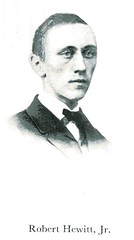 Speaking of Presidents, doesn't this guy look a little like Barack Obama? Jim writes:
Speaking of Presidents, doesn't this guy look a little like Barack Obama? Jim writes:
Here is a picture of Hewitt, probably taken in 1865/1866. This is in Adelson's book on the American Numismatic Society 1858-1958.
Jim adds:
In an article by George Clapp in the Coin Collector's Journal in 1942, he explains how he thinks this reverse was altered.
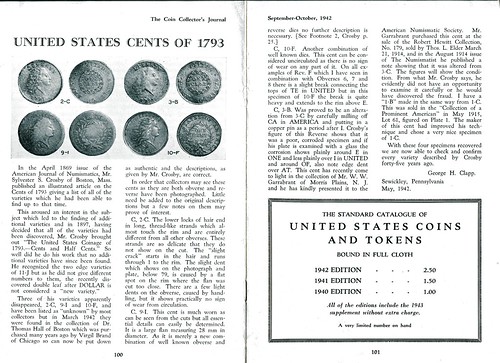
To read the earlier E-Sylum article, see: MORE ON THE SMITHSONIAN'S LINCOLN MEDAL (www.coinbooks.org/esylum_v15n15a09.html)
WAYNE'S NUMISMATIC DIARY: APRIL 15, 2012
Tuesday night was the April meeting of my northern Virginia numismatic social group, Nummis Nova. We met at Legal Seafoods in the Tyson's Galleria. Eric Schena was our host and he'd arranged for a private room.
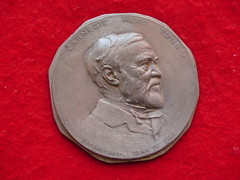 The venue was great. Our table was arranged in a large square, making it easy for everyone to see and talk to everyone else. The room has some extra tables set up, and these were used to display some exhibits. I laid out some recent purchases including the bronze and silvered Eric Newman medals made by the Rittenhouse Society and the recent Medal Collectors of America medal. I was most proud to show my "splasher" or lead die trial of a Carnegie Hero medal.
The venue was great. Our table was arranged in a large square, making it easy for everyone to see and talk to everyone else. The room has some extra tables set up, and these were used to display some exhibits. I laid out some recent purchases including the bronze and silvered Eric Newman medals made by the Rittenhouse Society and the recent Medal Collectors of America medal. I was most proud to show my "splasher" or lead die trial of a Carnegie Hero medal.
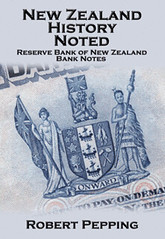 Jon Radel displayed his copy of Robert Pepping's New Zealand History Notes on the Reserve Bank of New Zealand Bank Notes. Eric had declared a theme of "Death and Taxes" and displayed an original tax collector's ledger from a town in Virginia. Later he passed around two pieces from his wife Heather's collection of undertaker tokens. We gave her the nickname "Morticia".
Jon Radel displayed his copy of Robert Pepping's New Zealand History Notes on the Reserve Bank of New Zealand Bank Notes. Eric had declared a theme of "Death and Taxes" and displayed an original tax collector's ledger from a town in Virginia. Later he passed around two pieces from his wife Heather's collection of undertaker tokens. We gave her the nickname "Morticia".
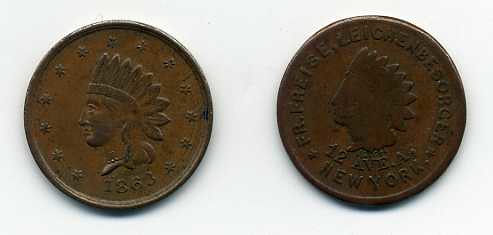
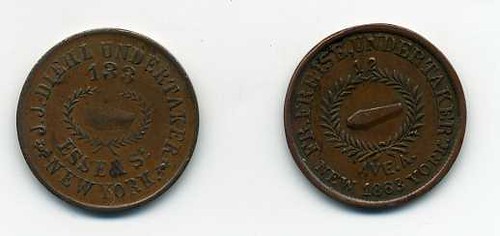
On a different topic Eric also passed around a token with a possible connection to the Andy Griffith Show. He writes:
Here's the I. T. Banks token from Mayberry, in Patrick Co., VA. The actress who played Thelma Lou said that while Andy Griffith modeled the TV town after Mt. Airy, he chose the name from this Mayberry. He himself said someone else chose the name. That said, Mayberry is ~20 miles north of Mt. Airy and the folks at the Mayberry Trading Post said he and his father used to come to the store.
In any event, I do like the tie-in of tokens to TV shows. As far as I know, the Banks tokens are the only ones from Mayberry. Next mission: get a token from the Virginia Soapstone Co. in Schuyler (Nelson Co.) - that's where the father of Earl Hamner of "The Waltons" fame worked. Walton's Mountain/Rockfish Depot was based on Schuyler and there's a museum there now.
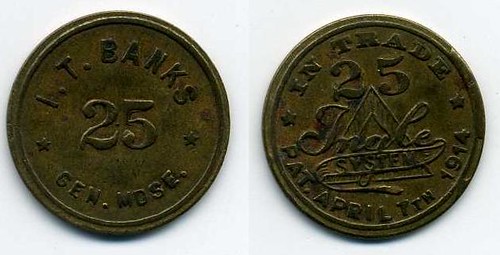
David Schenkman had a neat token, asking, "What denomination is it?"
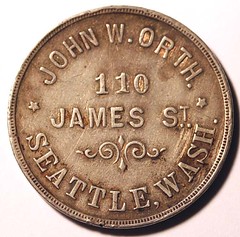
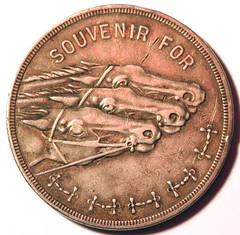
Dave writes:
I had my denomination collection out of the bank to photograph for an article. Most collectors don't realize that so many denominations and variations exist (for example, in addition to the common 5¢, it can be found expressed as Nickel, Half Dime, V¢., and .05¢).
This is one of the neatest; a 37mm silver token with one dollar expressed as 8 bits, with a bit on each of the three horses and 5 bits below. The Seattle merchant that issued it, John W, Orth, also issued tokens with one bit (12½¢) depicted.
Other attendees were Mike Packard, Julian Leidman, Joe Levine, Gene Brandenburg, Wayne Herndon and Roger Burdette. I sat next to Roger and we talked a good bit about one of the book manuscripts he has in progress.
Gene brought along a book for me: Report of the Director of the Mint Upon the Production of Precious Metals in the Year 1891. I had to let him know it was a commonly seen item, although this copy was in a nice binding with marbled boards. He had fun crying to everyone how I'd dissed his book, and others went overboard noting, "Well, he did say it had a swell binding..."
Mike Packard brought the best item of numismatic literature - a nice copy of the 1933 reprint of Sylvester Crosby's book on 1793 Cents and Half Cents. He'd bought it on eBay for a song. Great find!
The evening ended all too soon - it was another wonderful night of numismatic fellowship (not to mention decent food and an abundance of wine.
HAROLD LEVI COMMENTS ON JEFFERSON DAVIS IMAGES
Electrotype Bronze Portrait
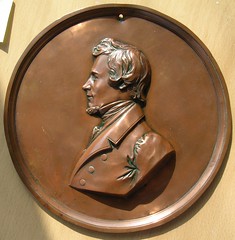 Jefferson Davis was U.S. Secretary of War from March 7, 1853 to March 4, 1857 in the Franklin Pierce administration. Davis was instrumental in upgrading the condition of the U.S. military during his administration. Ironically, he made great strides in preparing the U.S. military for the coming Civil War. These dates coincide with the proposed manufacture date of the electrotype portrait, which could have been made to honor the Secretary of War at that time.
Jefferson Davis was U.S. Secretary of War from March 7, 1853 to March 4, 1857 in the Franklin Pierce administration. Davis was instrumental in upgrading the condition of the U.S. military during his administration. Ironically, he made great strides in preparing the U.S. military for the coming Civil War. These dates coincide with the proposed manufacture date of the electrotype portrait, which could have been made to honor the Secretary of War at that time.
To read the earlier E-Sylum article, see: ELECTROTYPE PORTRAIT IDENTIFICATIONS (www.coinbooks.org/esylum_v15n15a07.html)
1903 Confederate Veterans Reunion Davis button.
 Varina Anne "Winnie" Davis is the daughter of Jefferson Finis Davis and Varina Banks Howell Davis. Under the name of Varina Anne Jefferson Davis, she published articles in periodicals, three novels and a biographical monograph.
Varina Anne "Winnie" Davis is the daughter of Jefferson Finis Davis and Varina Banks Howell Davis. Under the name of Varina Anne Jefferson Davis, she published articles in periodicals, three novels and a biographical monograph.
"Jefferson Davis died in 1889. His daughter, Winnie then inherited the property and when she died in 1898, Varina, Jefferson Davis' widow inherited the property. Mrs. Davis sold the property to the Mississippi Division of the Sons of Confederate Veterans with two stipulations. The first was that the property be used for a Confederate Veterans Home for the veterans and or their widows at no charge to them and that was done from 1903 until 1957 when the last three widows were transferred to a private nursing home in Greenwood, Mississippi, when it was no longer practical to keep them at the site.
The second stipulation for the sale of the property was that it be used as a memorial to Jefferson Davis and the Confederate Soldier; and that has been done from 1903 until the present time."
This information is from the Beauvoir website under the History tab. beauvoir.org/about/about.htm
To read the earlier E-Sylum article, see: QUERY: AGING A PERSON'S PHOTO TO HELP WITH ATTRIBUTION (www.coinbooks.org/esylum_v15n15a08.html)
SMITHSONIAN HIGHLIGHTS TITANIC CARNEGIE HERO MEDAL
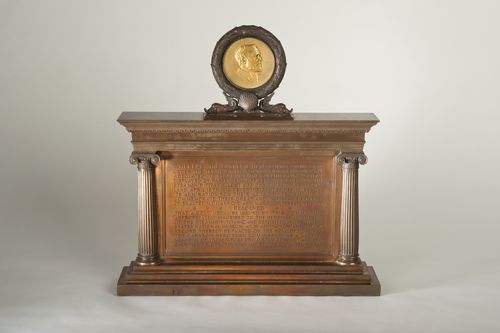
Finally, an interesting object in the museum's numismatics collection that you won't find on display is a 9 oz. gold medal that was donated to the Smithsonian in 1912 by the Carnegie Hero Fund Commission. The Carnegie Hero Fund Commission was established in 1904 by philanthropist Andrew Carnegie to recognize acts of heroism. According to Dr. Johnston, the impact of the Titanic's sinking on public opinion was so great that the Commission created a medal to honor heroes from the Titanic's sinking. The Commission didn't have a particular individual in mind for this award, so the medal was given directly to the Smithsonian.
You can hear about these objects and more by listening to the podcast recording of Dr. Johnston here. Additionally, listen to songs from 1912 and 1913 about the Titanic by following this link. The museum has many Titanic artifacts in its collections, both on and off view.
To read the complete article, see:
A tragedy's 100th anniversary
(blog.americanhistory.si.edu/osaycanyousee/2012/04/
a-tragedys-100th-anniversary.html)
KELLY & OLIVER ON THE DALLES MINT
Richard Kelly & Nancy Oliver write:
We have noticed a lot of information concerning the Dalles Mint, some of it incorrect, that has appeared in The E-Sylum lately, and we would like to clarify a few facts. We have included some information from one of our columns that appeared in the August, 2011 issue of "The Numismatist" and here is a synopsis of that column.
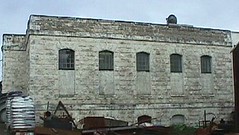 "In 1861, gold was discovered in Oregon about 150 miles southeast of the town of The Dalles located along the Columbia River. The Dalles became the center transfer point to send the miner's gold dust west along the Columbia to Portland where a steamer was then taken south to San Francisco and the gold dust was brought to the mint on Commercial Street to be made into coin or bars.
"In 1861, gold was discovered in Oregon about 150 miles southeast of the town of The Dalles located along the Columbia River. The Dalles became the center transfer point to send the miner's gold dust west along the Columbia to Portland where a steamer was then taken south to San Francisco and the gold dust was brought to the mint on Commercial Street to be made into coin or bars.
The need for a mint in Oregon became apparent, Portland fought to have a mint built there, but The Dalles won out. In 1865, Congress approved money to build it, but there were many delays. The most important occurred when the new mint's superintendent, William Logan, was killed in the wreck of the steamship Brother Jonathan in July of 1865.
Delays continued, until a new superintendent H.A. Hogue was appointed in June of 1868, and then things started looking up. Finally, in Feb of 1869, construction began with the blasting away of solid rock, but several projections of rock wouldn't budge, so 12 inches of concrete was laid on top for the foundation. Sandstone and granite for the two-story building came from a quarry just 5 miles away, and late in 1869, the first floor was completed and said to be quite attractive stonework.
However, there were several more work stoppages in 1870, one of them was the fact that the Treasury was re-thinking its need for a mint in Oregon, since gold production was slowing down in the state, and in addition there were cost overruns.
Nevertheless, construction resumed in March of 1871, and the 2nd story was halfway completed shortly thereafter. But on August 17th of that year, a destructive fire, started by 2 young boys, consumed much of the area around the mint. Because of its solid stonewalls, the mint held off the flames, and in fact, firefighters, from that point, were able to extinguish the flames of the surrounding area.
Shortly after this, the Treasury Department decided to not complete the building, even though construction was nearly finished. In March of 1875, Congress passed an Act giving the building to the state of Oregon for educational or charitable use. Unable to find a proper use for the building, the state sold it in 1889 to private citizens.
Over the years, various private concerns occupied the structure, and there were also several years when it was vacant. The building has also undergone several structural changes, but most of the rear section retains the distinctive stonework, which identifies it as the old mint that never was.
The Dalles Mint is the only mint approved and nearly completed, but never struck a coin.
Now almost 140 years old, the Erin Glenn Winery currently occupies what is left of The Dalles Mint building."
To read the earlier E-Sylum article, see: THE PROPOSED U.S MINT AT THE DALLES, OREGON (www.coinbooks.org/esylum_v15n14a08.html)

THE BANK OF ESTONIA MONEY MUSEUM
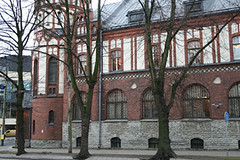 On a recent visit, I had the opportunity to view both the Bank of Estonia's own Money Museum as well as the History Museum's (Ajaloomuuseum) numismatic collection, both located in the heart of Tallinn, one of Europe's best-preserved medieval old towns...
On a recent visit, I had the opportunity to view both the Bank of Estonia's own Money Museum as well as the History Museum's (Ajaloomuuseum) numismatic collection, both located in the heart of Tallinn, one of Europe's best-preserved medieval old towns...
I had visited the Bank of Estonia's money museum some years ago when the premises occupied a much smaller space and the exhibitions were limited to that specific confine. Even then, the displays were well done, informative and they managed to put on show some extraordinary artifacts and items which were indeed fascinating and quite fascinating… real museum quality objects in a small central bank museum.
At the end of 2010, the Bank of Estonia carried out extensive renovations where the new museum would both increase in size and the premises would now integrate greater portions of the old Estonian Nobility's Credit Union, a landmark building adjacent to the Bank of Estonia's main premises. After more than a year's careful restoration, the new museum was opened in January of this year and, I can say first-hand, the wait was well worth it.
I was truly impressed with the restorative work carried out on the interior of the building itself with careful detail paid to the original marble and wood fixtures. The tower and spiral entrance itself is something to see with its stained glass windows (which miraculously survived the Soviet air-raids in 1944) depicting cultural life in the countryside and the hand-painted murals of national crests and emblems - also painstakingly restored.
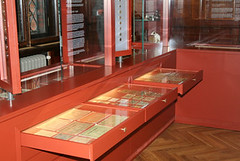 The Money Museum includes every banknote and coin issued since independence in 1918 - from initial promissory and credit notes to the first actual currency banknotes denominated in the original Marka system. In one specific featured display, are the very printing plates eventually re-discovered in 2000 by the Bank of Estonia which had been carefully buried in 1940 by a diligent employee perhaps thinking the Bank may need to re-print banknotes after the Soviet invasion.
The Money Museum includes every banknote and coin issued since independence in 1918 - from initial promissory and credit notes to the first actual currency banknotes denominated in the original Marka system. In one specific featured display, are the very printing plates eventually re-discovered in 2000 by the Bank of Estonia which had been carefully buried in 1940 by a diligent employee perhaps thinking the Bank may need to re-print banknotes after the Soviet invasion.
These printing plates went on display after they were un-earthed in a special exhibition in 2002 and I had the opportunity to review the new addition shortly after their initial debut. Dated with their year of their intended issue of 1940, the plates were used for an initial print run but, these notes were never used and eventually all Krooni notes of that era were withdrawn and forcibly exchanged for USSR roubles. I am told that the Bank never discovered who the loyal Bank employee was who had heroically hid the printing plates for their eventual and hoped-for later use. The plates now form part of the permanent displays of the bank's exhibition.

For any coin & banknote enthusiast, a visit to the Money Museum is a must-see attraction. Tallinn has emerged as a very exciting and vibrant city who has managed to preserve the character and structure of its colorful Hanseatic & medieval past. As a collector, another reason to visit is the museum's gift shop where you can purchase the latest coins and sets direct at issue prices.
To read the complete article, see:
Estonia's Numismatic Past and Present at the Bank of Estonia Money Museum
(news.coinupdate.com/estonia-numismatic-past-and-present
-at-the-bank-of-estonia-money-museum-1316/)
BOWERS OFFERS TANENBAUM CIVIL WAR TOKENS
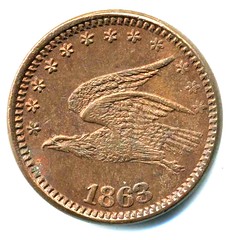 In March Dave Bowers and Steve Hayden made an outright purchase of the Steve Tanenbaum Collection of Civil War tokens from the Tanenbaum Estate. The collection was divided, and Dave acquired the states of Connecticut, Indiana, Kentucky, Maine, Massachusetts, New Jersey, New York, Ohio, and Tennessee.
In March Dave Bowers and Steve Hayden made an outright purchase of the Steve Tanenbaum Collection of Civil War tokens from the Tanenbaum Estate. The collection was divided, and Dave acquired the states of Connecticut, Indiana, Kentucky, Maine, Massachusetts, New Jersey, New York, Ohio, and Tennessee.
Steve Tanenbaum was a leading dealer and scholar in the series from the inception of his interest in the 1960s until his unfortunate passing in 2011. These are the tokens he selected for his personal reference collection. The vast majority of them are in Mint State (!) and within the assigned grades virtually all are "high end," the finest of their kind.
Dave has calculated the prices by a formula based on extrapolating his cost. The tokens, nearly all one of a kind in the estate, are offered on a first-come, first-served basis and subject to prior sale. Those certified by NGC bear the Tanenbaum Collection notation on the holder and, as appropriate, past owners. Those not in holders will be sent with a certificate signed by me attesting they are from the Steve Tanenbaum Collection.
A photograph of each will be taken, furnishing a permanent record of the pedigree. Postage and insurance will be added to invoices. Any item not satisfactory, if purchased at the price listed (not otherwise negotiated), can be returned without explanation for a full refund within 10 days of receipt. It is anticipated that at a later date certain items will be consigned to auction with Stack's Bowers Galleries, which has a fine track record in the token field, including the Lindesmith, Dice-Hicks, Ford, Bleviss, and other cabinets over a period of time.
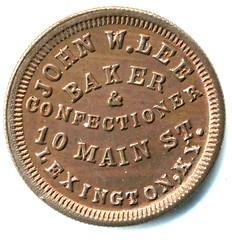
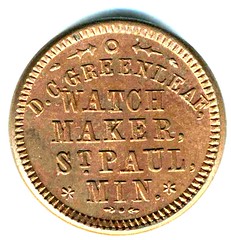
Dave adds:
"To my knowledge the present Steve Tanenbaum Collection offering is absolutely unique in the annals of numismatics. The estate involved well into seven figures. I have catalogued and priced so far the tokens from Connecticut alphabetically to New York State as far as part way through New York City. Many pieces are R-10 (unique), including hitherto unpublished varieties."
If you'd like a list by e-mail, send Dave a note at qdbarchive@metrocast.net with your name, e-mail address, and postal address and he will send it to you with his compliments.
SOME SOUTH AFRICAN KRUGERRANDS FOUND TO BE UNDERWEIGHT
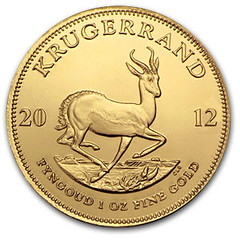 The world's most popular gold coin and one of South Africa's most famed collectors' items - the krugerrand - is under a cloud after some were found to be underweight.
The world's most popular gold coin and one of South Africa's most famed collectors' items - the krugerrand - is under a cloud after some were found to be underweight.
The SA Mint Company, a subsidiary of the Reserve Bank, has admitted that it made underweight proof or collector krugerrands.
Economist Dawie Roodt, a former chief economist at the Reserve Bank, said while mistakes happen, "it is worrying".
"These coins were cast at the SA Mint Company and basically didn't have enough gold in them. We should be concerned because this company belongs to the Reserve Bank, which is an important state institution," he said.
In a statement on Friday, the bank confirmed that the coins, produced between April and May last year, did not meet "required quality specifications".
The scandal comes in the wake of the suspension late last year of two top executives of the SA Mint Company, managing director Andile Mvinjelwa and Tom Davel, general manager: numismatic coins.
Neither Mvinjelwa nor Davel could be reached for comment this week.
Late last year, members of the SAAND were called to a meeting at the bank and told of problems concerning the coins.
It is understood that dealers were made to sign confidentiality agreements that prevented them from talking about the problematic coins.
Reserve Bank spokesman Hlengani Mathebula said local and international coin dealers had been informed of the underweight coins. A verification process showed that some coins appeared to be "under specification to varying degrees".
He said that of the 1500 minted in that period, six were found to be below the required weight.
To read the complete article, see: Krugerrand scandal rocks SA Mint (www.timeslive.co.za/local/2012/04/15/krugerrand-scandal-rocks-sa-mint)
FEATURED WEB SITE: USPATTERNS.COM
This week's Featured Web Site is the home of The Society of U.S. Pattern Collectors.Welcome to the home of The Society of U.S. Pattern Collectors!
For those of you not familiar with this fascinating area of numismatics, patterns are prototypes for coins that, for the most part, were never approved for circulation. Most patterns are very rare, some unique, and others unknown outside of museums.
A good place to start learning about these pieces is our Beginner's Corner which includes a page on How to use this Website or the Photo Gallery which contains examples of many of the different pattern issues.
The United States Mint produced well over a thousand different patterns, as well as many die trial and experimental pieces. Despite the great rarity of many of these individual items, the great variety makes the series surprisingly collectible.

www.uspatterns.com
